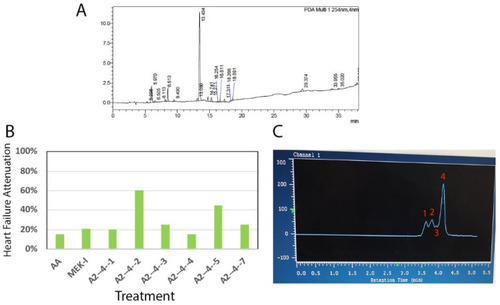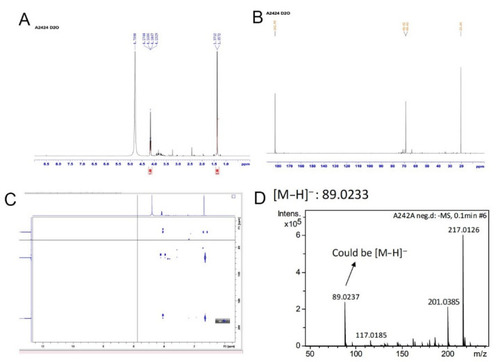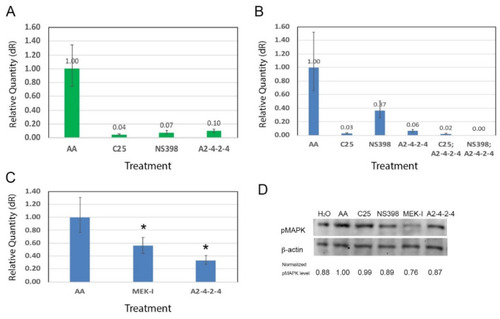- Title
-
Identification of Lactate as a Cardiac Protectant by Inhibiting Inflammation and Cardiac Hypertrophy Using a Zebrafish Acute Heart Failure Model
- Authors
- Haege, E.R., Huang, H.C., Huang, C.C.
- Source
- Full text @ Pharmaceuticals (Basel)
|
AHF attenuation by Trapa taiwanensis Nakai compounds. Two crude extracts from Chinese water chestnuts (Trapa taiwanensis Nakai) were generated using different solvents, 50% ethanol for C2 and water for C3. Initial tests using our zebrafish model showed AHF attenuation activity. Both C2 and C3 extracts were proceeded with medium pressure column chromatography (MPLC) to generate fractions eluted out with methanol gradient, 20%, 40%, 60%, 80% and 100%. Due to the large volume, C3-20% was further divided into two fractions, C3-20%-1 and C3-20%-2. (A) C3-20%-1 showed greater than 40% AHF attenuation. Although C2-80% and C2-100% also showed attenuation in this representative experiment, they failed to show the same activity in the later experiments. (B) The compounds in C3-20%-1 were further separated into ten fractions, named A1 to A10. A2 repeatedly showed significant AHF attenuation activity. A1 and A6 were not tested due to a too-little yield of compounds. |
|
A2-4-2-4 purification. (A) HPLC analysis showed many compounds in the A2 fraction. (B) The A2-4 fraction was further separated into seven fractions, A2-4-1 to A2-4-7. Among them, A2-4-2 showed the highest AHF attenuation activity. (C) A representative UV absorbance graph during the preparative HPLC for A2-4-2 revealed that the A2-4-2 fraction contains four UV absorbance peaks which are significantly overlapped. Although extreme care was taken to separate the compounds into the final four fractions, named A2-4-2-1 to A2-4-2-4, the NMR analysis eventually showed impurities in A2-4-2-4 (see Figure 3). |
|
Chemical analyses for A2-4-2-4. A2-4-2-4 was analyzed using NMR and ESIMS. (A) The 1H-NMR graph indicates a methyl group (δH 1.3, d, J = 7.0 Hz) and a methane group (δH 4.16, q, J = 7.0 Hz) in A2-4-2-4. (B) The 13C-NMR indicates a carboxyl group (δC 182.5), a hydroxyl group (δH 68.6), and a methyl group (δH 20.4) in the major compound in A2-4-2-4. (C) The 2-dimensional NMR, using heteronuclear multiple bond correlation, further confirmed that the major compound in A2-4-2-4 is lactate. (D) ESIMS analysis revealed that the molecular weight of the major compound in A2-4-2-4 is 89.0233 (C3H6O3). |
|
A2-4-2-4 pharmacodynamics. (A) A2-4-2-4 showed the heart failure attenuation activity in a dosage-dependent manner. (B) Time course experiments showed that A2-4-2-4 is required at the early phase of AA-induced AHF. Embryos were treated with AA from 24–72 hpf and A2-4-2-4 added at different times, 24, 30, 36, 42, or 48 hpf. The attenuation of A2-4-2-4 was about 70% when added at 24 hpf but dropped to 35% when added six hours later at 30 hpf (* indicates statistical significance by t-test, p = 0.038; ** between A2-4-2-4 (36) and A2-4-2-4 (30), p = 0.014). A2-4-2-4 lost 90% of the attenuation efficacy when added 24 h later (70% at 24 hpf vs. 7% at 48 hpf). (C) A combinational experiment with sub-dosage of the compounds identified in our lab, 10 μM of NS398, 1:500 dilutions of A2-4-2-4, 5 μM of MEK-I, 2 μM of C25, showed a possible synergistic effect between A2-4-2-4 and NS398, comparing the attenuation of double treatment by NS398; A2-4-2-4 (78.6%) with that of lone NS398 (25.2%) or A2-4-2-4 (34.9%) treatment. (* indicates the statistical significance by t-test, p < 0.05). Similarly, the data suggest a possible synergistic effect between A2-4-2-4 and C25 (* indicates statistical significance by t-test, p < 0.05 between the double versus single treatments) but an additive effect between A2-4-2-4 and MEK-I. PHENOTYPE:
|
|
Possible molecular mechanisms of A2-4-2-4. (A) The COX-2 gene expression, measured by qRT-PCR, was high in embryos treated with AA alone but significantly lower in those treated with AA plus C25, NS398, or A2-4-2-4. (B) A2-4-2-4 showed a synergistic effect with NS398 in suppressing inflammation. While the COX-2 expression level in embryos treated with AA and a sub-dosage of NS398 was 0.37 folds of that in embryos treated with AA alone, the COX-2 level was near zero in the embryos treated with NS398; A2-4-2-4. (C) The tnnt-2 expression, an indicator of cardiac hypertrophy, was high in embryos treated with AA alone but significantly lower in embryos treated with AA plus MEK-I or AA plus A2-4-2-4. (* indicates statistical significance between the compound and AA control, t-test, p < 0.05.) (D) Western blotting with anti-phosphorylated MAPK (pMAPK) showed that A2-4-2-4 moderately suppressed the MAPK signaling pathway. The normalized pMAPK level was done by dividing the band intensity in pixels using photoshop of pMAPK by that of β-actin for each sample. EXPRESSION / LABELING:
PHENOTYPE:
|
|
Sodium lactate attenuates AHF. AHF in zebrafish embryos was induced by (A) 10 μM AA from 24–72 hpf or (B) 5 μM AA from 24–96 hpf, as lower concentration AA takes a longer time to induce severe heart failure phenotypes. Sodium lactate was added to test its AHF attenuation ability at two concentrations (L, 1.5 mM; H, 15 mM). A2-4-2-4 was set up at two concentrations as well (L: 1:1000 dilution lactate; H: 1:300 dilution). Several positive compounds, NS398, MEK-I and C25, were set up for comparison. |
|
Sodium lactate mechanisms. (A) COX-2 gene expression by qRT-PCR in zebrafish embryos treated with AA alone or with test chemicals: NS398, C25, sodium lactate, NS398; sodium lactate, or C25; sodium lactate. Sodium lactate suppresses COX-2 expression. (B) Relative levels of phosphorylated NF-κB in zebrafish embryos treated with different compounds. The quantification was done by measuring the pixels of the phosphorylated NF-κB bands and were normalized by that of β-actin on three Western blot images using Photoshop. Sodium lactate treated embryos showed a significantly lower level of phosphorylated NF-κB. (* indicates statistical significance by t-test, p = 0.001). (C) Additive effect of AHF attenuation by NS398 and sodium lactate. (Y axis: heart failure attenuation percentage). (D) Tnnt2 expression measured by qRT-PCR was significantly lower in the embryos treated with sodium lactate. (* indicates statistical significance by t-test, p < 0.05). |







